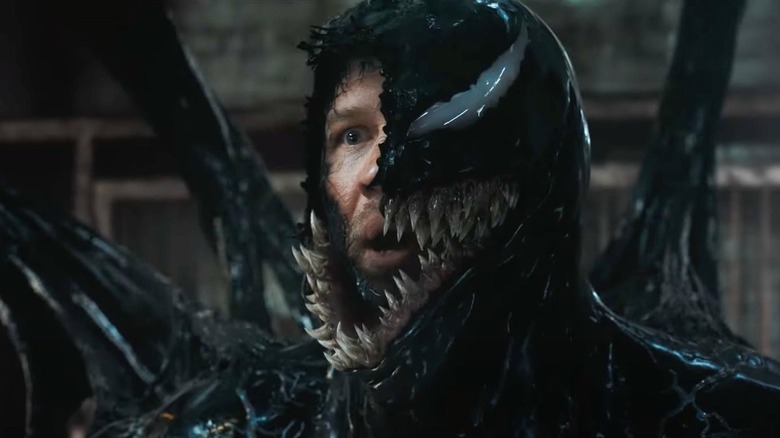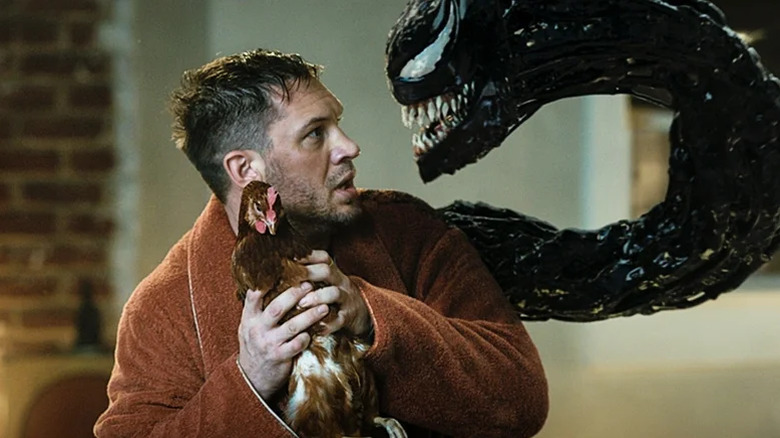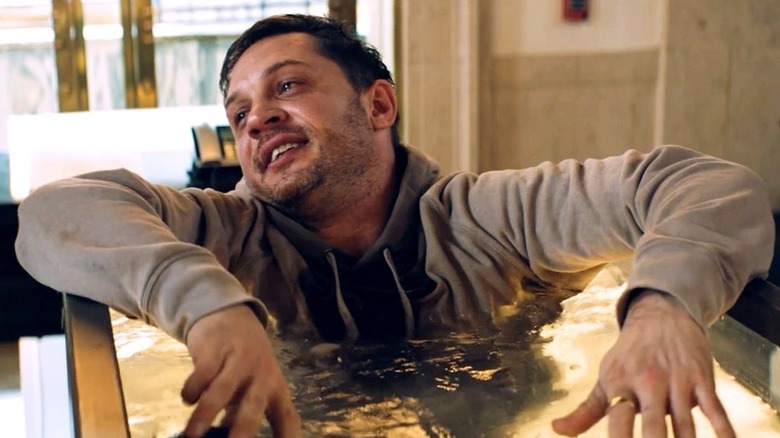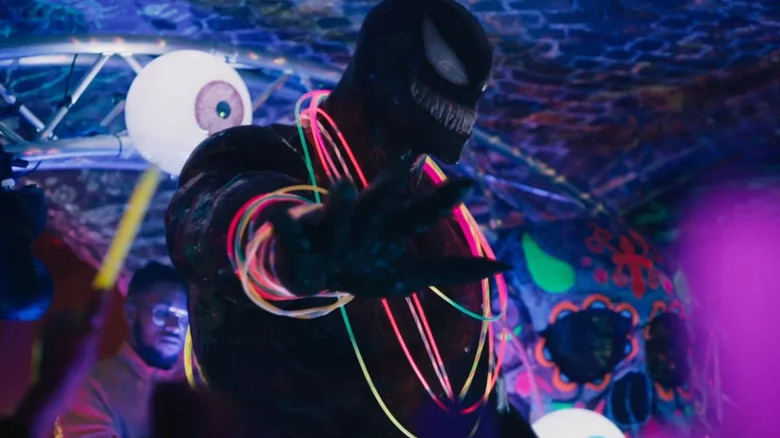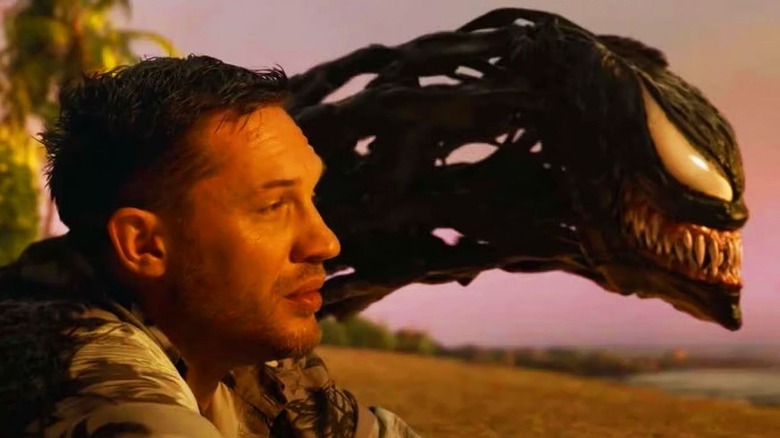How To Watch Tom Hardy's Venom Movies In Order
Sony's Spider-Man Universe (previously known as the Sony Pictures Universe of Marvel Characters, or SPUMC) is arguably the most bizarre movie franchise experiment since the Dark Universe, an experiment full of baffling choices that failed spectacularly. These are movies that form a cinematic universe revolving entirely around Spider-Man, featuring many of his most popular villains and even a few allies, all without actually featuring the web-slinger — though we do get an origin story of sorts for Peter Parker in "Madame Web."
The one good thing to come out of this bad experiment was the "Venom" movies starring Tom Hardy. At the very least, these movies knew not to take themselves very seriously, with "Zombieland" director Ruben Fleischer setting the tone with the first "Venom" and Andy Serkis pushing it further in the sequel to becoming a hilarious, campy, and very queer franchise featuring an unhinged performance by Hardy, and one of the best romances in a superhero movie in Eddie and Venom.
It's a wild trilogy of movies, often bad, sometimes wildly good, always with at least some unhinged side character (Woody Harrelson's wig, anyone?), and a set of movies that deserve to be watched. Since the "Venom" movies skip a traditional numeric sequence, there is a small chance you might be confused as to where to start. If for reason that's you, you'd want to watch the trilogy in release order (which is the same as canonical chronological order, the best and only way to watch these movies). So if you want to watch the "Venom" movies in order from the start, follow this order:
-
"Venom" (2018)
-
"Venom: Let There Be Carnage" (2021)
-
"Venom: The Last Dance" (2024)
Keep reading for a breakdown of the franchise and why this is the best way of experiencing the "Venom" movies.
Why is that the correct order to watch the Venom movies?
This is a rather simple, traditional trilogy, with a three-part structure. There is no timeline shenanigans, no going back in time, no spin-offs to think about. The "Venom" movies are uncomplicated, a sequence of stories following Eddie and Venom's meet-cute, the development of their relationship, and ultimately their painful goodbye.
Sure, there is a teeny, tiny little crossover reference to the otherwise entirely separate Marvel Cinematic Universe at the end of "Let There Be Carnage" due to the events of "Spider-Man: No Way Home," but it gets resolved immediately in "The Last Dance," so there is no need to watch the non-Venom movie (except for a blink-and-you-miss-it shot that connects both universes).
Indeed, the "Venom" movies are as simple as they come, lacking in subtlety (which is for cowards anyway), and telling a straightforward story. At the very least, unlike the rest of the now dead Sony's Spider-Man Universe, the "Venom" trilogy has a clear beginning, middle, and end. Let's take a look at each individual entry in the trilogy and how it evolves the central relationship.
Venom (2018)
Directed by Ruben Fleischer ("Zombieland"), the first "Venom" is by far the weakest of the trilogy, a movie that isn't sure whether to be serious and gritty, focusing on the body horror of Eddie sharing a body with an alien monster, or a campy and funny movie about sharing your body with an alien monster who eats brains but is also kind of a loser.
Nevertheless, there are some interesting ideas introduced in the film. For one, the idea that Venom is not some formidable killer from an alien world, but rather a refugee on the run from his people, who consider him a good-for-nothing loser. That idea gives way to the trilogy's (and, truly, the entire Sony's Spider-Man Universe) approach of making Venom an anti-hero rather than a villain. Sure, Venom does eat brains, and he loves devouring kittens, but he also fancies himself a superhero, a "Lethal Protector" toward the end of the film.
Still, the reason this whole trilogy is worth starting is in two hilariously bizarre scenes. One is the moment Venom takes over Michelle Williams' body and makes out with Eddie before taking over his body — the first kiss between Eddie and Venom. The other is the wild lobster tank scene, a delightfully weird moment that feels like nothing else in the film, a scene that exists because Tom Hardy insisted on it to the point where they built a whole tank for Hardy to fit in. It's moments like these that set the "Venom" movies apart from other superhero joints, that make this an oddball trilogy of sorts.
Venom: Let There Be Carnage (2021)
This is it. This is the pinnacle of not just the "Venom" trilogy, not just Sony's Spider-Man Universe, but superhero movies in general. Well, probably not that last part, but "Venom: Let There Be Carnage" is nevertheless a delightfully goofy romantic comedy that also happens to be a superhero movie, and secretly the gayest superhero movie ever made at that.
That's right, there is no subtlety here, no attempt at hiding the fact that Eddie and Venom are a couple and letting fans make their own conclusions. It is extremely obvious from the first scene that this is a movie about a couple figuring out their relationship after moving in together, but before taking things to the next step. This is the movie in which Venom finally comes out, during the best scene of the trilogy, one where Venom winds up at a rave and gives a speech about being kept hidden by his partner Eddie, and about how love is love in what director Andy Serkis described to Uproxx as Venom's "coming out party." It's a wild movie, and it makes up for its flaws (everything to do with Woody Harrelson's Carnage) by deepening the Eddie and Venom relationship.
Venom: The Last Dance (2024)
Not every relationship ends well, and not every romantic comedy ends with a happily ever after. From the opening scene of "Venom: The Last Dance," there is a sense of finality, a sense of melancholy at the knowledge that all good things must one day end. This is a rushed, overstuffed movie that commits the cardinal sin of pulling the focus away from Eddie and Venom and spending way too much time with other, uninteresting characters.
For one, the movie tries to establish the Thanos of the Sony's Spider-Man Universe but fails to earn any excitement or even curiosity about the villainous Knull. Like every other film in this bizarre cinematic universe, there is zero connection to any of the other movies, let alone to Spider-Man. Still, it's not without merit. Venom gets a dance sequence at a Las Vegas hotel that's dazzling, while writer-director Kelly Marcel gives the movie a topical message about refugees and migrants that makes this a timelier and more political movie than even the latest "Captain America." Better yet is the ending of the movie, which uses Maroon 5's "Memories" for a hilariously weird montage that bookends this weird yet unique trilogy.
